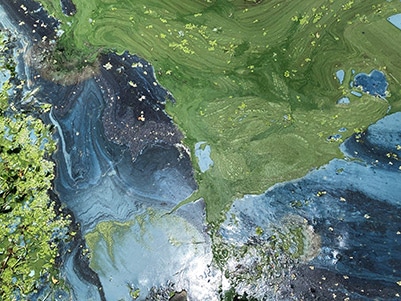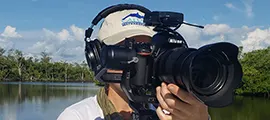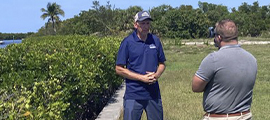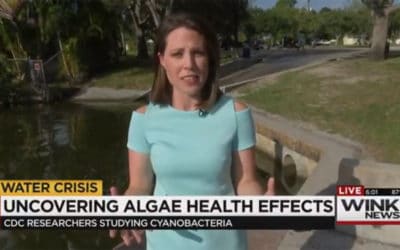Issue:
Harmful Algal Blooms

Blue-green Algae (Cyanobacteria)
Cyanobacteria is one of the oldest types of lifeforms on Earth and is found primarily in freshwater systems. There are thousands of species of cyanobacteria and many are known to produce a variety of toxins.
Cyanobacteria is a photosynthetic microorganism that processes sunlight, nitrogen and phosphorous to live. They can regualate their position in the water column for optimal light and thrive in warm, nutrient-rich fresh or brackish water with low turbulence.
Microcystis and Anabaena are two of the most common cyanobacteria found in estuarine systems today. These bacteria are known to produce cyanotoxins dangerous to humans and animals. Microcystin and Anatoxin are classes of hepatoxin and neurotoxin, affecting the liver and brain, respectively.
Human and animal exposure to Cyantoxins comes in three primary forms of contact:
- Dermal contact
- Inhalation or aspiration from aerosolized surface water
- Ingestion
Harmful algal blooms have severe impacts on human health, aquatic ecosystems and our economy.
Red Tide (Karenia brevis)
Red tide is a marine dinoflagellate found in saltwater, and has been known to inhabit the Gulf of Mexico throughout recorded history. Red tide blooms have been increasing in scope and intensity within the last 30 years. Red tide has also occurred throughout the Gulf and Atlantic Coast, reaching as far as North Carolina.
Karenia brevis can utilize at least 12 different forms of nutrients and also consume other single cell organisms for food. They are capable of motion and directed swimming allowing them greater access to nutrients.
Red Tide produces brevatoxins which can be deadly to many sea animals and often causes acute respiratory symptoms in humans. Aerosolized health effects include irritation of the eyes, nose, throat and lungs and exacerbating occurrences of respiratory distress, bronchitis, asthma and pneumonia. Brevatoxin can also have a serious impact on the marine food-chain, contributing to shellfish poisoning and gastrointestinal disorders.

Take Action
Contact Your State Legislators
Calusa Waterkeeper calls on citizens and stakeholders to urge elected officials and responsible agencies to take the following ten actions:
The toxic blue-green algae (cyanobacteria) often stretching from Lake Okeechobee to our west coast is the result of decades of failed water policy implementation. A perfect storm of lax enforcement and under-funding at the local, state and national levels has culminated in the historic harmful algae blooms (HABs) that plagued our region in 2018 (and so many other years).
If political leaders fail to take action, history is doomed to repeat itself year after year, causing catastrophic harm to our ecosystem and our economy.
The science is clear on what needs to be done.
What has been lacking is the political will to enact the regulation and legislation required to begin to reverse these problems. We look to you, as informed citizens, to proactively communicate your water quality concerns to newly elected officials. It will take a groundswell of voices if we are to affect change in Tallahassee during this coming legislative session.
Find Your Legislators
Related News Stories
Harmful Algal Blooms
CDC Plans to Uncover the Health Effects of Blue-Green Algae
It is dangerous. But what can it do to your health? That is the question at the center of the water quality crisis. Now, researchers with the Centers for Disease Control and Prevention are trying to get you answers. They are focusing on the people exposed to the algae blooms.
CDC to Study How Inhaled Algae Toxins Affect Lake Okeechobee Fishing Guides
Federal scientists plan a first-ever study of Lake Okeechobee fishing guides to help understand the long-term health effects of the lake’s cyanobacteria blooms. The Centers for Disease Control and Prevention intends to recruit 50 volunteers for the research.
Florida Legislature Must get Serious About Nutrient Pollution in the Water
So far, the Florida legislative session has not adequately addressed the nutrient pollution time bomb that leads to harmful algal blooms (HABs). Great sums of public dollars have been promised and budgeted but without substantive regulatory reform, the problem will only continue and become more expensive.
Researchers Find Blue-green Algae Toxin in Dolphins that also have Brain Disease
A toxic blue-green algae that choked the Fort Myers-Cape Coral area last summer has shown up in dolphins with brain disease. Researchers tested 14 stranded dolphins and all but one of the dolphins tested positive for the cyanobacterial neurotoxin known as BMAA as well as brain disease.
New Study Shows Alzheimer’s-like Brain Disease in Dead Florida Dolphins
Toxic blue-green algae hit SWFL hard in 2018. Dolphins washed up on our shores by the dozen. Newly released research by scientists at the University of Miami found dead dolphins poisoned by blue-green algae showed signs of Alzheimer’s-like brain disease.
Lake Okeechobee Releases Cause Concerns about Water Quality & Algae Blooms
Lake Okeechobee releases started again last week, and the results are a mixed bag for the Caloosahatchee and its delicate estuary. The volume of water is not concerning to many local environmental groups, but they do question the quality of water coming from the big lake.
Make a Donation
Get Notified
Priority Issues
Harmful Algal Blooms
Cyanobacteria & Red Tide
Cyanobacteria (blue-green algae) and Karenia brevis (red tide) have been making major impacts on Southwest Florida.
Lake Okeechobee Discharges
Revise System Operating Manual
The Caloosahatchee River often suffers from too much freshwater in the wet season, and not enough freshwater in the dry season.
Cape Coral Spreader Canals
Nutrient & Sediment Loading
The City of Cape Coral is working to remove large storm-water barriers to make recreational boating more convenient.
Bacteria Monitoring
Fecal Indicator Bacteria
Calusa Waterkeeper has been at the forefront of monitoring this Fort Myers tributary for fecal bacteria indicators.




































